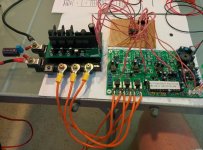Well that was a fun few days.... kinda

First things first once I arrived here in Aus we had to get the 74HC04 CMOS inverter to buffer the signals from the brain board to the IPM and build a small prototype board to wire it up.
No problems with this and while working on it my brother (bluefang) worked on hooking up the HubMonster motor and the various battery packs (one for the brain board (50V), one for the motor (125 initially then down to 50V once we realised I had the brain set up for that), and one for the IPM interface board(24V). Also put a fuse in the motor battery pack line to prevent letting free the magic smoke (not so successful as you will see later).

Once we had this all setup we went into the menu and started setting everything up, set the PWM freq to 15khz since the IPM is rated to 20khz. Set the current limits to 5 amp battery to match the fuse. Did the inductance measurement and the motor made a noise and gave a measurement of about 100uh so it seemed happy.
Once that was setup the moment of truth arrived and we tried driving the motor but as always nothing

well we got a little bit of a twitch but no constant movement.
We tried both with and without the HF tone, when we enabled to HF tone we did the current sensor calibration and it seemed to work fine first one it made a noise second one it made a noise and moved a small distance. when not using the HF tone we set the current calibration back to defaults.
At this point we were going to switch to the newer 2.30 chip but I wanted to check as I remember something about the schematic changing from 2.10 to 2.30.
Played around with the erpm limits a little bit with no success and then found if I turned up the throttle quickly I could get the motor to start spinning and the drive 3 LED would light just for a few seconds and then the motor and LED would stop. Did this once or twice and blew the 5A fused we were using so thought good maybe we are too current limited. Replaced the 5amp fuse with a 25amp and changed the maximum battery current to 15amps to see if more power would help keep the motor going.
Alas at this point after trying the fast throttle trick a few times the motor started making a cogging noise even with no throttle so we disconnected and reconnected power to the controller thinking maybe it got stuck in a loop of some kind, no change still cogging with no throttle then the IPM blew

25A fuse was fine so I am thinking a current pulse must have done it since the IPM is rated at 50A.

Not the best end to the day.
Now looking to get a replacement IPM and see if Lebowski has any comments on what we did wrong and if we can switch to the 2.30 chip?
Cheers
Chris (and Derek/bluefang)



